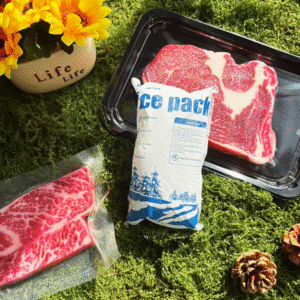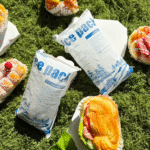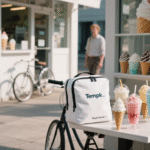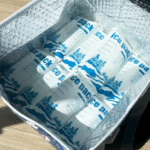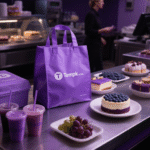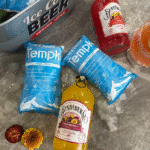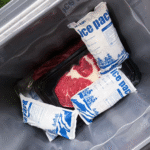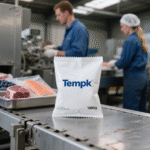How Do Outdoor Dry Ice Packs Keep Goods Cold in 2025?
Proper temperature control matters whether you’re shipping a life saving vaccine or packing a picnic. Sebuah outdoor dry ice pack is your secret weapon because solid CO₂ stays at –78.5 °C (–109.3 °F) and sublimates into gas without leaving moisture. Custom sized packs can maintain ultra cold conditions for up to 72 jam, Dan 2025 regulations require ventilation and clear UN1845 labels. This guide explains why outdoor dry ice packs are indispensable for outdoor adventures and cold chain logistics, how to choose and customize them, the safety rules you must follow and what innovations to watch in 2025.
Why outdoor dry ice packs are essential for camping and hiking: understand how sublimation keeps your cooler dry and your food safe and how to pack them.
How to customize an outdoor dry ice pack for cold chain shipping: learn about cell counts, insulation materials and weight to duration rules.
Safety and regulatory requirements: discover UN1845 classification, venting rules and weight limits, plus handling tips to prevent frostbite.
Choosing between dry ice, PCM and gel packs: compare temperature ranges, durations and when hybrid systems make sense.
2025 trends and market insights: explore sustainable materials, IoT monitoring and how demand for dry ice packs is growing.
Why Are Outdoor Dry Ice Packs Essential for Camping and Hiking?
Immediate Answer
Outdoor dry ice packs provide ultra cold, moisture free cooling that lasts longer than regular ice, making them ideal for extended trips and sensitive foods. Dry ice stays at –78.5 °C, so it can keep meat, fish or ice cream frozen for several days. Because dry ice sublimates directly into carbon dioxide gas, it leaves no liquid mess, protecting packaging and preventing soggy food. For long journeys or off grid camping, blocks offer slower sublimation and longer hold times, while nuggets work for shorter outings.
Deep Dive and Practical Advice
Imagine setting out on a three day hike without access to refrigeration. Traditional ice melts and pools water at the bottom of your cooler, potentially damaging packaging and raising bacterial risks. Dry ice provides a cleaner alternative: place a block at the bottom of your cooler, separate it with a cardboard or towel layer, then stack your food on top. Udara dingin tenggelam, so this arrangement keeps items uniformly chilled while preventing direct contact. Pre cool your cooler with regular ice, limit opening to retain cold air, and crack the lid slightly or use a vented cooler to let CO₂ escape. The diagram below illustrates these layers:
Types of Outdoor Dry Ice Packs
Blok vs.. nugget: For camping and hiking, dry ice is sold in blocks or nuggets. Blocks sublimate more slowly and provide steady cooling, making them ideal for multi day trips. Nuggets or pellets cool quickly but don’t last as long; they are useful for day hikes or when you need rapid chilling. You can also purchase flexible dry ice sheets composed of 5–20 cells; these sheets can be cut to fit your cooler or shipping box, ensuring efficient space usage.
Hybrid packing: Many adventurers use a combination of dry ice and regular ice. Place dry ice at the bottom or top to create a deep freeze zone and add regular ice for items that just need chilling. This approach creates multiple temperature zones in one cooler and helps regulate sublimation.
| Dry Ice Form | Lamanya & Pendinginan | Suitability | Manfaat praktis |
| Memblokir | Slow sublimation; keeps contents frozen for several days | Long camping or hunting trips | Maintains consistent sub zero temperatures without moisture |
| Nugget/Pellet | Fast cooling but shorter duration | Day hikes or quick refresh | Rapidly chills items and can be distributed around contents |
| Sheet (5–20 cells) | Dapat disesuaikan; 24–72 h hold time depending on cell count and insulation | Camping or shipping where space is limited | Cuts to fit container, optimizes weight, mengurangi limbah |
Practical Tips and Suggestions for Outdoor Use
Long backpacking trip: Use a block of dry ice at the bottom of a high R value cooler and layer non frozen items on top; pre freeze perishables before departure. Crack the lid for ventilation and wear gloves when handling.
Weekend getaway: Combine nuggets with regular ice to create two temperature zones. Keep items you need frequently on top to minimize cooler opening.
Campuran kargo (frozen and fresh): Separate frozen food (MISALNYA., daging) from fresh produce with cardboard or different compartments to prevent freezing sensitive items.
Kasus nyata: A hiking group used a 10 lb block of dry ice wrapped in a towel, plus regular ice on top. They pre cooled the cooler and separated drinks in another compartment. The block kept meat and fish frozen for three days while salads and fruits stayed crisp, and there was no water at the bottom.
How to Customize Outdoor Dry Ice Packs for Cold Chain Shipping?
Immediate Answer
Customized outdoor dry ice packs match your cargo’s size and hold time, ensuring precise temperature control, reducing waste and cutting costs. By choosing the right number of cells (5–20), selecting suitable materials like kraft paper or Mylar and trimming sheets to fit your box, you can maintain ultra cold temperatures (–78,5 °C) selama 24-72 jam. This tailored approach reduces empty space, cuts dry ice consumption and minimizes freight weight.
Deep Dive and Customization Steps
Select cell count and size: Dry ice sheets are made of connected cells. More cells mean longer duration but higher weight. For narrow boxes, cut the sheet to match your container; a 10 cell sheet trimmed to 7 cells reduces weight and prevents overcooling. Maintain 5–10 lb (2.3–4.5 kg) es kering per 24 h of transit as a rule of thumb. Adjust this based on insulation quality and ambient temperature.
Choose insulation material: Kraft paper bags provide natural insulation and are recyclable; Mylar or reflective foil reduces heat gain; reinforced plastic bags offer puncture resistance; foam inserts increase the container’s R value for shipments beyond 48 H. Pairing materials optimizes performance; MISALNYA., kraft paper with foam inserts offers sustainability and longevity.
Select outer packaging: Heavy duty films with strong seals prevent leaks and allow custom printing. Reusable bags endure 50+ siklus; disposable bags offer convenience but generate waste. Branding options let you print handling instructions and logos.
| Customization Aspect | Options | Mengapa itu penting bagi Anda |
| Cell count | 5–20 cells per sheet; trim to fit | Reduces waste and optimizes cooling duration |
| Bahan isolasi | Kraft paper, Mylar/foil, foam/Styrofoam | Determines how long dry ice lasts; eco friendly options support sustainability goals |
| Outer bag features | Heavy duty film, strong seals, custom printing | Prevents breakage and leaks; printed instructions enhance compliance |
| Reusable vs.. disposable | Reusable sheets last 50+ siklus; disposable packs are single use | Reusable packs lower cost per use and reduce environmental impact |
Practical Tips for Customization
Mulailah dari yang kecil: Order sample sheets from multiple suppliers and run thermal validation tests. Evaluate hold time and fit before committing.
Combine refrigerants: For shipments over 48 jam, pair a customized dry ice sheet with PCM bricks or hydration packs to create a hybrid system.
Label and train: Use printed bags to display handling instructions, hazard labels and weight. Train staff and customers on safe handling.
Stay sustainable: Choose renewable CO₂ sources—dry ice produced from bioethanol fermentation captures CO₂ that would otherwise be vented—and select recyclable kraft bags. Encourage returns of reusable packs and partner with suppliers offering recycling programs.
Contoh kasus: A biotech firm shipping cell therapy products switched to customized dry ice sheets with integrated sensors and added foam liners. By matching cell count and insulation, they extended hold time from 36 h to 60 h and reduced product loss by 90 %.
What Safety and Regulatory Rules Apply to Outdoor Dry Ice Packs?
Immediate Answer
Dry ice is classified as UN1845, a Class 9 bahan berbahaya, so vented packaging, proper labelling and protective gear are required. Containers must be ventilated to allow CO₂ gas to escape, and packages must display the UN1845 identifier and Class 9 label bahaya. Different transport modes have weight limits—200 kg per package for air shipments, 2.5 kg (5 lb) for USPS and no specific limit for ground shipments—and shipments exceeding 5.5 lb must comply with U.S. hazardous materials regulations.
Deep Dive and Safety Guidance
Handling precautions: Always use insulated gloves and goggles when handling dry ice; direct contact can cause severe frostbite. Use tongs when possible and avoid touching with bare hands. Never store dry ice in airtight containers or closed vehicles—ventilation prevents pressure buildup and suffocation risks.
Transport and storage: Untuk pengiriman udara, weight is limited to 200 kg per package and requires an air waybill and shipper’s declaration. USPS air mail limits dry ice to 2.5 kg (5 lb) per paket. Ground shipments have no specific weight limit but must still be vented and labelled. In the U.S., non medical shipments containing more than 5.5 lb of dry ice must comply with 49 CFR and IATA rules.
Storage and disposal: Store dry ice in a well ventilated area and an insulated container; keep it out of passenger compartments and away from children or pets. Allow unused dry ice to sublimate in a ventilated space and never dispose of it in sinks or drains.
| Shipping Method | Maximum Dry Ice Weight | Ventilation Requirement | Documentation Required | Practical Meaning |
| Udara (Passenger/Cargo) | 200 kg per paket | Venting required | Di Waybill, Deklarasi Shipper | Follow airline rules; declare weight and use vented containers |
| Tanah (DOT) | No specific limit | Venting required | Usually exempt from hazmat paperwork | Use vented packaging but enjoy greater flexibility |
| USPS (Air Mail) | 2.5 kg (5 lb) | Venting required | Kelas 9 label and net weight marking | Only small quantities allowed; ideal for sample shipments |
Practical Safety Tips
Penanganan: Always wear insulated gloves and use tools when manipulating dry ice. Provide clear instructions to end users to avoid direct contact.
Ventilasi: Crack the cooler lid or use containers with vent holes. Do not transport large amounts of dry ice in closed vehicles; if you must, keep windows open.
Separation: Do not pack dry ice with products sensitive to freezing, such as flowers or certain pharmaceuticals. Keep food items sealed to prevent flavour changes.
Dokumentasi: If shipping by air or internationally, include the UN1845 label, weight and hazard declaration. For shipments over 5.5 lb, consult IATA and 49 CFR regulations.
Incident case: One logistics provider shipped a custom dry ice pack without vent holes, causing the box to crack due to CO₂ pressure. After redesigning packaging to include vents and training drivers, the company prevented incidents and maintained compliance.
Kapan Anda harus menggunakan es kering, PCM or Gel Packs?
Immediate Answer
Choose dry ice for shipments requiring sub zero temperatures (–20 °C to –78.5 °C) and long hold times; use PCM or gel packs for chilled ranges (0 ° C ke 8 ° C.); combine refrigerants for hybrid solutions. Dry ice provides ultra cold, moisture free cooling for 24–72 h. Phase change materials (PCM) melt and freeze at preset temperatures and offer stable cold but cannot reach dry ice’s extreme lows. Gel packs are non hazardous, reusable and ideal for chilled foods or cosmetics.
Detailed Comparison
Paket es kering: Solid CO₂ sublimating at –78.5 °C, Ideal untuk vaksin, ice cream or research materials. They produce no liquid and maintain deep freeze for 24–72 h. Namun, they require hazmat labelling, ventilation and handling precautions.
Paket PCM: Engineered substances that change phase at specific temperatures (MISALNYA., 0 ° C., –20 °C). They provide narrow, controlled temperature bands and are safer to handle. PCMs are reusable but heavier and cannot reach ultra cold levels.
Gel or water packs: Water based, non hazardous refrigerants melting around 0 ° C.. Ideal for meal kits and produce; they maintain 2–8 °C for 12–36 h. They are cost effective and reusable but cannot keep goods frozen.
| Pendingin | Kisaran suhu | Durasi khas | Recommended Uses | Safety and Regulations |
| Paket es kering | –20 °C to –78.5 °C | 24–72 jam (depends on weight and insulation) | Pengiriman beku (vaksin, es krim, terapi sel), long camping trips | Requires UN1845 labelling, ventilation and gloves |
| Paket PCM | Pre set ranges (0 ° C., –20 °C) | 24–48 h | Pengiriman dingin (kit makan, elektronik) | Non hazardous; fewer regulations; lebih berat |
| Gel/water pack | Around 0 ° C. | 12–36 h | Makanan segar, kosmetik | Non hazardous; dapat digunakan kembali; cannot freeze |
Practical Tips When Choosing
Match the temperature requirement: For shipments that must stay below –20 °C, choose dry ice; for 0–8 °C, gel or PCM is sufficient.
Pertimbangkan durasi: Use hybrid systems combining dry ice and PCMs for transit times over 48 h to stabilize temperatures and reduce dry ice consumption.
Account for regulations: Dry ice requires hazmat paperwork when above 5.5 lb; gel and PCM packs do not.
Evaluate sustainability: PCM and gel packs are reusable; dry ice produces CO₂ but can be sourced from renewable processes.
2025 Latest Developments and Trends in Outdoor Dry Ice and Cold Chain Logistics
Ikhtisar Tren
Demand for temperature sensitive goods is driving innovation in cold chain logistics. Di dalam 2025, several trends are reshaping outdoor dry ice packs and packaging:
Bahan berkelanjutan: Recyclable and biodegradable packaging options such as kraft paper and biodegradable films are becoming standard. These materials reduce waste and appeal to eco conscious consumers.
Pemantauan Cerdas: IoT enabled sensors integrated into dry ice sheets provide real time temperature and humidity data. Logistics teams can intervene proactively to prevent excursions.
Sistem Pendinginan Hibrida: Combining dry ice with PCMs smooths temperature fluctuations and reduces total dry ice needed.
Automation and robotics: Automated packing and cutting systems increase throughput and consistency, reducing human error.
Circular economy models: Take back and refurbishment programs encourage the return and reuse of thermal materials, reducing waste and cost.
Latest Advancements At a Glance
Sensor pintar: Dry ice sheets with embedded sensors transmit temperature data to logistics platforms, allowing proactive rerouting or replenishment.
Pendinginan hibrida: Systems that pair dry ice with PCMs extend duration and stabilize temperature profiles, enhancing safety and reducing CO₂ consumption.
Otomatisasi & robotika: Machines precisely cut and place dry ice sheets, increasing productivity and reducing packer variability.
Bahan berkelanjutan: Biodegradable films, recyclable kraft paper and renewable CO₂ sources minimize environmental impact.
Market growth: The cold chain packaging market is forecast to reach US$27.1 billion in 2025 and could expand to US$104.7 billion by 2035. Demand for next day dry ice pack sheets is projected to grow 20 % setiap tahun melalui 2026.
Wawasan pasar
The global cold chain packaging market, valued at US$27.1 billion in 2025, is expected to exceed US$104.7 billion by 2035 with a CAGR of 15.8 %. Growth is driven by increased trade in perishable goods, stricter regulations and the expansion of e commerce and meal kit services. The dry ice market, estimated at US$1.54 billion in 2024, may reach US$2.73 billion by 2032. Namun, CO₂ supply constraints and price volatility highlight the need for efficient usage and alternative refrigerants. Companies are investing in renewable CO₂ sources and hybrid systems to address these challenges.
Pertanyaan yang sering diajukan
Q1: How long does an outdoor dry ice pack last?
Most outdoor dry ice packs maintain ultra cold temperatures for 24–72 hours depending on cell count, insulation and ambient conditions. Blocks last longer than nuggets, and hybrid systems with PCMs can extend duration beyond 72 H. Always pre cool your container and adjust the number of cells to match transit time.
Q2: Can I combine dry ice and gel packs in one cooler?
Ya. Combining dry ice with gel or PCM packs creates different temperature zones and slows sublimation. Place dry ice near items that must remain frozen and use gel packs for chilled goods. This hybrid approach is ideal for trips where you need both frozen and fresh items.
Q3: How much dry ice should I pack for a shipment or camping trip?
As a rule of thumb, use half the weight of your payload in dry ice for overnight shipments and equal weight for up to 48 jam. Untuk 72 jam, mengemas 1.5 times the weight of your product. You may adjust based on insulation quality and external temperature.
Q4: Are outdoor dry ice packs reusable?
Many dry ice sheets and bags are designed for reuse and can endure 50+ siklus. Check manufacturer instructions, inspect for damage and refreeze according to guidelines. Reusable packs reduce cost per use and environmental impact.
Q5: What items should I avoid packing with dry ice?
Avoid packing products sensitive to freezing, such as fresh flowers, certain pharmaceuticals or live seafood. Dry ice’s extreme cold can damage these items. Keep food items sealed to prevent texture or taste changes.
Q6: Do I need special documentation to ship dry ice internationally?
Ya. Dry ice is a hazardous material under UN1845, and international shipments must comply with carrier and IATA regulations. Include a Shipper’s Declaration for Dangerous Goods, state the net weight of dry ice and ensure your packaging is vented and labelled.
Ringkasan dan Rekomendasi
Kunci takeaways: Outdoor dry ice packs keep goods frozen and dry for extended periods, making them indispensable for camping, hiking and cold chain shipping. Customizing cell count and materials improves efficiency and reduces waste. Safety matters—follow UN1845 regulations, use ventilated containers and wear gloves. Choose dry ice for deep freeze needs, PCMs or gel packs for chilled ranges, and hybrid systems when you require both. Emerging trends—sustainable materials, smart monitoring and automation—are transforming cold chain logistics.
Saran yang dapat ditindaklanjuti: Assess your cargo or trip needs and select the right refrigerant. Pre cool containers, pack an appropriate weight of dry ice and always provide ventilation. Experiment with customized dry ice sheets to improve fit and reduce consumption. Invest in IoT sensors for high value shipments and choose suppliers who use renewable CO₂ and recyclable materials. For expert guidance, consult Tempk’s specialists for a customized assessment.
Tentang tempk
Tempk is a leading provider of cold chain logistics solutions. We design and manufacture dry ice packs, gel packs and insulated packaging that maintain ultra low temperatures while prioritising safety and sustainability. Our dry ice sheets are customizable with 5–20 cells, high strength seals and eco friendly kraft or foil materials. We integrate IoT sensors to offer real time temperature monitoring and use renewable CO₂ sources to reduce carbon footprints. We support clients across pharmaceuticals, food delivery and outdoor adventure by providing tailored, compliant cold chain solutions.
Panggilan untuk bertindak: Ready to optimise your cold chain or outdoor adventures? Contact Tempk’s experts for personalized recommendations and learn how our outdoor dry ice pack solutions can keep your goods cold, safe and sustainable.






